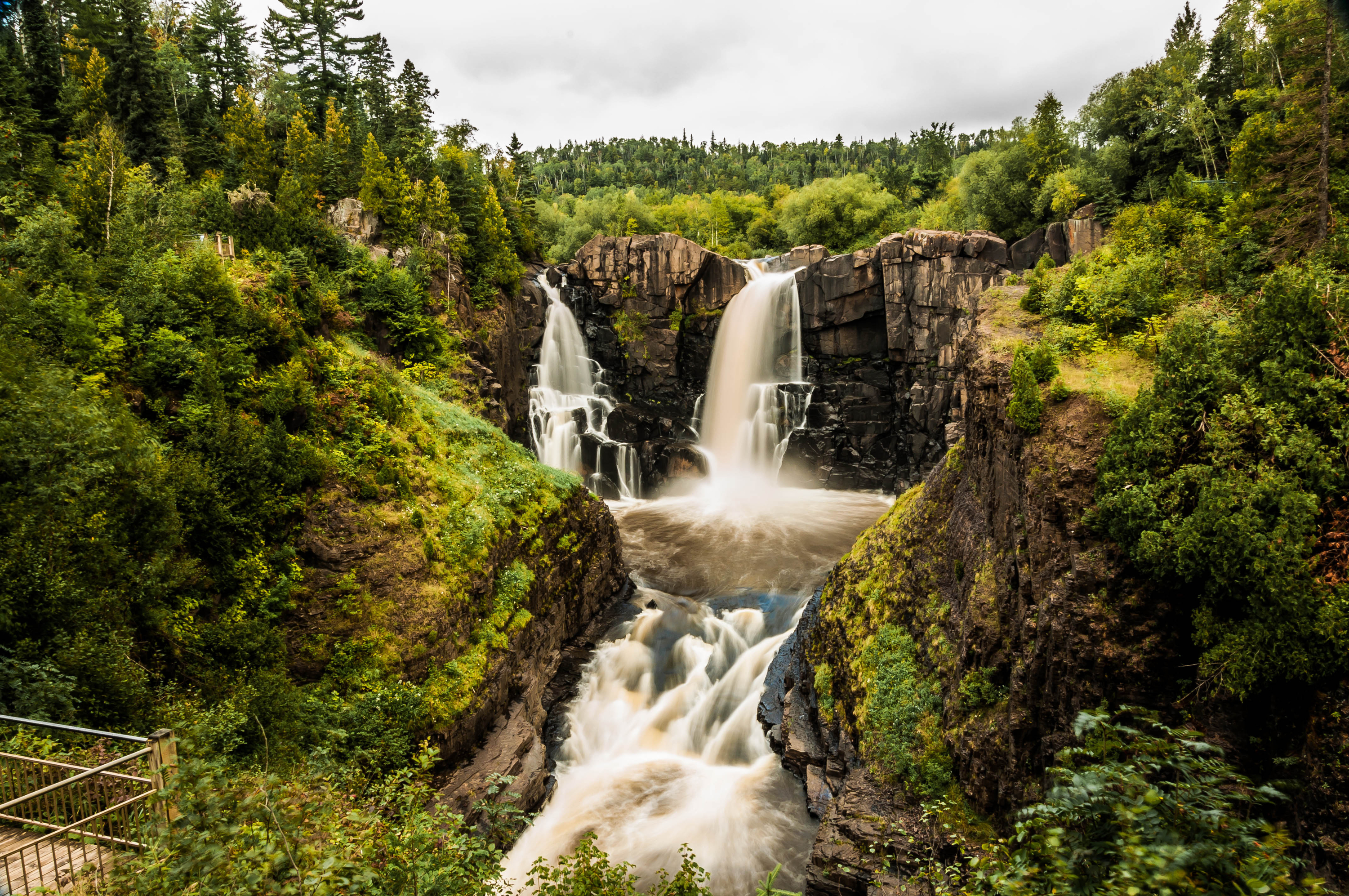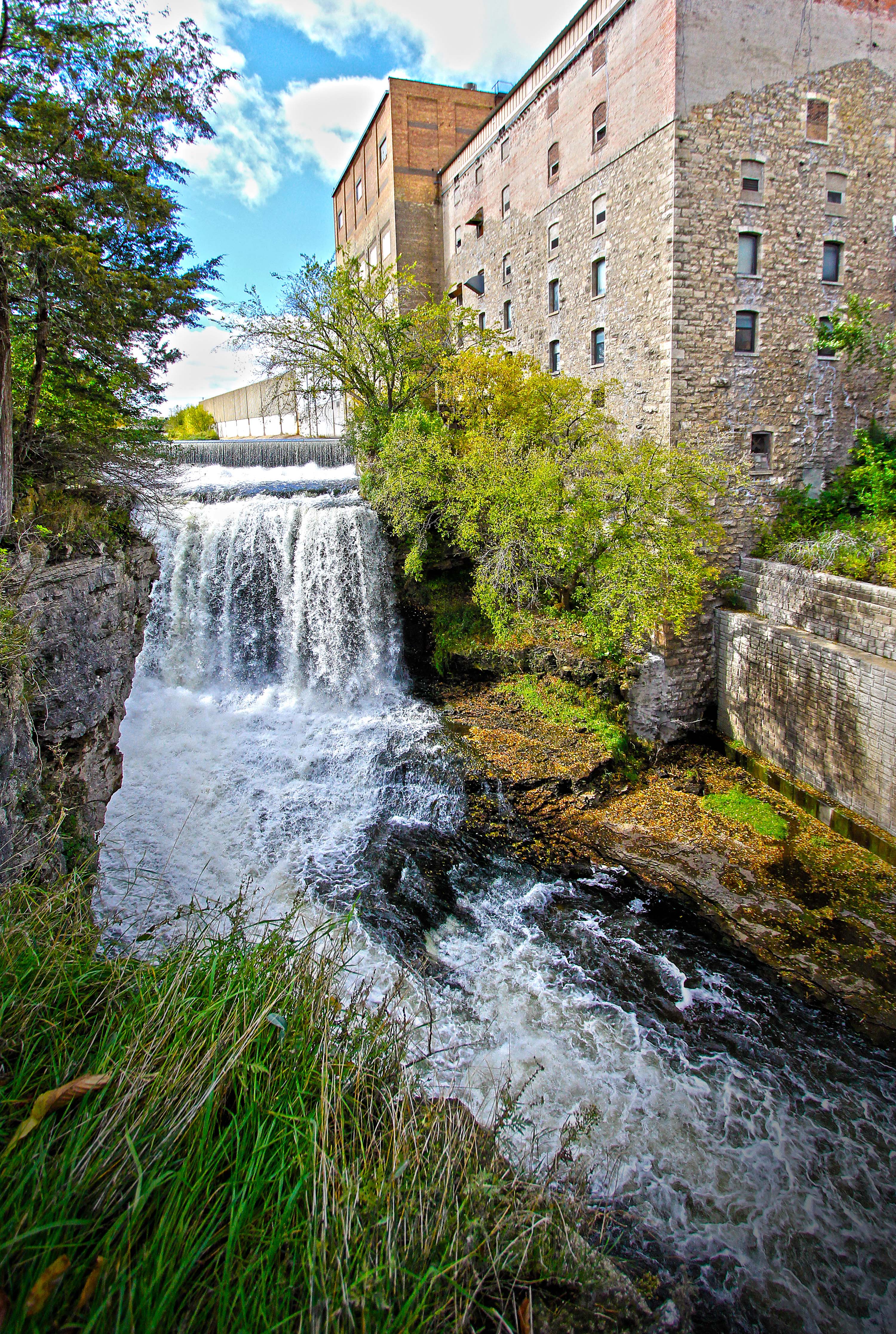
Minnesota's Best Waterfalls
Minnesota's Best Waterfalls
By Lisa Meyers McClintick
Many say spring is waterfall season in Minnesota due to rapid snow melt and thundering, fast-flowing waterfalls. These majestic sights are a top place to visit any time of year; have you ever seen a frozen waterfall? Let this list guide you to the state's most awe-inspiring waterfalls.
-
Beaver River Falls, Beaver Bay

Sunset over Beaver River Falls in Beaver Bay / Jackie Scherer
Beaver River Falls, Beaver BayIn Lake County, there are more than 12 waterfalls, the most of any county in Minnesota. Find Beaver River Falls in Beaver Bay alongside a wayside stop on Lax Lake Road. Follow the pedestrian path to catch the cascades as they flow into Lake Superior. The wayside stop also has a picnic area and restrooms.
-
Caribou Falls, Finland

Caribou Falls / Credit: North Shore Explorer
Caribou Falls, FinlandIn Silver Bay, get to the Caribou Falls State Wayside by taking a half-mile hike along the Superior Hiking Trail near the Caribou River. Steps will lead you down to the stars and is a hidden gem among locals and parking is available.
-
Devil's Kettle, Hovland

The mysterious Devil's Kettle Falls at Judge C.R. Magney State Park / August Schwerdfeger, shared under CC BY 4.0
Devil's Kettle, HovlandFollow Lake Superior’s shoreline about 30 miles southwest to see Minnesota’s most unusual waterfall: Devil’s Kettle on the Brule River. Visitors can park or camp at Judge C.R. Magney State Park north of Grand Marais and hike to the waterfalls where the water splits. One side tumbles 50 feet into a pool that flows to Lake Superior, and the other plunges underground and disappears. Where that water went was a mystery to onlookers and geologists alike, until 2017 when DNR scientists were able to confirm that the water resurfaces somewhere downstream.
-
Gooseberry Falls, Two Harbors

Hopping through Gooseberry Falls on foot in Two Harbors / Micah Kvidt
Gooseberry Falls, Two HarborsThe Waterfalls Walk within Gooseberry Falls State Park is a short route that highlights the middle and upper falls, and can be ADA accessible if you use the ADA trail segment instead of the stairs. The Falls View Loop is a non-ADA accessible and longer route that features the park's Middle, Upper and Lower Falls.
Gooseberry Falls is one of the biggest draws on the 60-mile North Shore Scenic Drive between Lutsen and Two Harbors, where you can find the gentle Cascade Falls at Cascade River State Park; marvel at dramatic gorges and massive potholes carved out at Temperance River State Park; admire Cross River Falls right on the highway at Schroeder; and hike back to High Falls or Illgen Falls at Tettegouche State Park. The region also boasts Split Rock Lighthouse State Park, which has its own beautiful 20-foot waterfall along a section of the Superior Hiking Trail.
Still not satisfied? Be sure to drive 20 minutes past Lutsen to find the Gitchi Gami State Trail and Fall River Falls. The Grand Marais landmark has lovely views of the river mouth in Lake Superior.
-
Hidden Falls, Nerstrand

Hidden Falls at Nerstrand Big Woods State Park / Credit: Shazam Hanif
Hidden Falls, NerstrandAbout one hour south of Minneapolis is Hidden Falls at Nerstrand Big Woods State Park. Walk along a one-half mile trail to get to the waterfall and at the trailhead is a picnic area and parking lot.
-
High Falls, Grand Portage

High Falls Waterfall, Grand Portage / Eve Schrank
High Falls, Grand PortageYou have to head north — right around the Canadian border — to see Minnesota’s highest waterfall as it plummets 120 feet down the Pigeon River at Grand Portage State Park. Fur traders used the Snake River in the late 1700s-early 1800s, and it’s quickly apparent why they carried their large canoes around this daunting waterfall, which can double in size during the spring.
-
Manitou Cascades, Finland

George H. Crosby Manitou State Park / Dana Hernandez
Manitou Cascades, FinlandAt George H. Crosby Manitou State Park, enjoy the cascades of the Manitou River after a gorgeous and rugged hike. The walk to the falls is about one mile each way and the park has minimal facilities.
-
Minnehaha Falls, Minneapolis

Minnehaha Falls in winter / Lane Pelovsky, courtesy of Meet Minneapolis
Minnehaha Falls, MinneapolisMinnesota's most popular waterfall anchors Minnehaha Regional Park, where you can hike, rent a bike, catch a concert or kick back on the patio at the seasonal outdoor dining standby Sea Salt Eatery and its new side hustle The Sandwich Room. Don't miss it during the winter, either; as you can see in the above shot, it's about as majestic as Minneapolis gets during the colder months.
For a more secluded experience in the Twin Cities, head to Hidden Falls, a popular regional park among locals that also includes Crosby Farm.
-
Minneopa Falls, Mankato

Minneopa Falls / Pei Ketron
Minneopa Falls, MankatoSouthern Minnesota’s largest waterfall can be found at Minneopa State Park. Its gentle creek burbles through the hardwood forest until it falls like a curtain across two terraces in a mossy gorge west of Mankato. On the other side of the Minnesota River, about eight miles away, Minnemishinona Falls cascades into a narrow ravine along the scenic Judson Bottom Road.
-
Niagara Cave Falls, Harmony

Niagara Cave / Ryan Taylor
Niagara Cave Falls, HarmonyAbout 140 miles southeast of the Twin Cities, almost to the Iowa border, you can find an unusual twist on the typical waterfall on the outskirts of Harmony. The catch? You must head underground on a Niagara Cave tour to see the almost 60-foot-high waterfall. It’s one of the unique features of this cave, which was once popular for underground weddings. (It still boasts a small chapel among its natural features.)
-
Ramsey Falls, Redwood

Redwood Falls in Ramsey Park
Ramsey Falls, RedwoodRamsey Falls is tucked into 219-acre Ramsey Park, the state’s largest municipal park and a popular spot for camping, hiking and visiting a small zoo with buffalo, deer, prairie dogs and waterfowl.
-
St. Anthony Falls, Minneapolis

Bike or walk across the Mississippi River on the Stone Arch Bridge in downtown Minneapolis / Paul Vincent
St. Anthony Falls, MinneapolisSt. Anthony Falls along the mighty Mississippi River has attracted people for thousands of years for its religious significance to the Dakota people, its economic importance to the area, and its beauty. For one of the best viewing points, walk across the iconic Stone Arch Bridge and stop at the nearby visitor center.
-
Vermillion Falls, Hastings

Vermillion Falls in Hastings / David Youngren
Vermillion Falls, HastingsVermillion Falls Park is popular for picnics, exploring, and, of course, its spectacular, 35-foot star. After your visit, explore Hastings' charming downtown area to find restaurants, antique shops, a brewery, and more.
-
Winnewissa Falls, Pipestone

Winnewissa Falls at Pipestone National Monument / Credit: Myra Smisek
Winnewissa Falls, PipestoneSouthwest Minnesota is known more for prairie and farm land than waterways. That makes the majestic Winnewissa Falls at Pipestone National Monument a surprise when walking among pink quartzite rocks and learning about the area’s continued spiritual significance to American Indians.
-
Wolf Creek Falls, Sandstone

Spotting a waterfall among the autumn colors in Banning State Park / Claudine Grove
Wolf Creek Falls, SandstoneThe Kettle River in Sandstone — a hot spot for whitewater rafting, rock climbing, and ice climbing in winter — is home to Wolf Creek Falls and Big Spring Falls within Banning State Park. About an hour away is the short Lester Park hike that'll take you to Lester River and Amity Falls. Elsewhere in the area, Congdon Park along Tischer Creek offers great hiking trails and views of a waterfall.

A hiker hangs out with his dog at Gooseberry Falls / Credit: Micah Kvidt
KNOW BEFORE YOU GO
-
A vehicle permit is required to enter Minnesota state parks. Save time by ordering one online before you arrive at the park.
-
For comfort and safety on the trail, be sure everyone has appropriate footwear (tennis shoes, not flip-flops).
-
Bring a water bottle for each hiker as well as plenty of sunscreen, bug spray and snacks.
-
Pick up a paper map at the park office or load a GeoPDF map before you leave (don’t rely on your phone to navigate because cell and Internet service may not be available in the woods).
-
The accessible trails at Minnesota state parks are stroller friendly as well as wheelchair friendly.
-
Some Minnesota state parks have all-terrain electric wheelchairs for use on unpaved trails.
-
If your dog will be hiking with you, keep it on a leash and clean up after it.
-
Don't pick wildflowers or otherwise disturb the landscape. "Take only photos, leave only footprints."

















